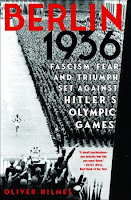11. Oliver Hilmes, Berlin 1936: Fascism, Fear, and Triumph Set against Hitler's Olympic Games (2016) (7/16/24)
A first entry in my new quest to learn more about the rise of fascism in the early twentieth century, this book presents more a kaleidoscope of impressions than any sort of a history lesson. But having a sense of the emotions of a time is also important, and that's what this book tries to create.Berlin 1936 is set against the sixteen days of the eleventh modern Olympiad, as Hitler, having solidified his power within Germany, was setting out to dominate Europe more largely. During those Olympics, with the entire world as his audience, he made a show of conciliation and peace. As soon as the games ended, however, everything would change.
But that's not really the message of the book. If there is a message. It's structured day by day—one chapter for each of the sixteen days the games ran, and a final "What became of...?" chapter at the end. In each, we are presented with short vignettes or stories about individuals—athletes (a Jewish German fencing star, a Dutch swimmer, Jesse Owens of course), nightclub hosts, the writer Thomas Wolfe, Goebbels and Göring (and their rivalry), a woman who commits suicide under a train, a young Roma girl, the French and American ambassadors to Germany, Wolfe's publisher Rowohlt and his right-hand man (and illegitimate son) Heinz Ledig, Goebbels's cheating wife, the publisher of a virulently anti-Semitic newspaper... and on and on. So we learn about many people—some steadfast Nazis, some oblivious to the politics of the Reich, some toeing a careful line.
I'm not sure I'd call the book a success, really, since it didn't accomplish anything. But the short sections do keep you reading, and you do emerge with a sense of chaotic spectacle, which soon would devolve into full-blown fear for many, unquestioning loyalty for others, escape for some, or death.
Here's a description of Göring,
the last of the Renaissance men—at least in his own estimation. It's not clear precisely what he means when he uses the phrase, although if we equate that period in human history with brutality, excess boatfulness, gluttony, greed and corruption, then yes, Göring is indeed the last Renaissance man. And that self-conferred appellation is only one of his titles. The others include Prussian Interior Minister, Prussian State Premier, Deputy Reich Representative in Prussia, President of the Prussian State Council, President of the Reichstag, Reich Forestry Minister, Reich Hunting Minister, Reich Aviation Minister, Reich Commissioner for Air Travel, President of the Reich Aerial Defense Association, Colonel General, Supreme Commander of the Luftwaffe and many, many more. For ever one of his offices, Göring draws a separate salary, and for each of his functions he has a special uniform designed by himself. Sometitmes he appears attired entirely in white, sometimes in light blue, sometimes in a reddish-brown doublet with baggy sleeves, green boots and a spear in his hand. In private, he prefers kimonos of violet silk that flatteringly conceal his considerable bulk. Göring loves accessories. He wears gemstone rings and golden daggers and swords. Meetings with tailors, hairdressers, jewelers, perfumiers and art dealers are all part of the Renaissance man's regular duties.
Or here's a passage about actor and cabaret artist Werner Finck, whose "gift for seemingly accidental, passing remarks makes [propaganda minister] Goebbels see red." In 1934 Goebbels has him arrested and sent to the Esterwagen concentration camp, but in July 1935 Finck is released on Göring's behest, and he is allowed to write a daily column about everyday life for the Berliner Tageblatt newspaper.
Finck, however, cannot curb his tongue, taking risks with allusions and wordplay. In the final instalment of his column, he writes: "The visitors from all over the world are leaving. Never have they been so spectacularly welcomed. The question is: how have Leni's cameras recorded it all?" Finck imagines Leni Riefenstahl inspecting the negatives of footage of Jesse Owens's spectacular triumphs. "Suddenly she sees in reverse how positively the Negro ran. In the negatives, we get our revenge. The white man is at the head of the pack. Meters in front of the others, while the black fellows bring up the rear!"
With this book I learned a little bit of something, but I have much further to go.


No comments:
Post a Comment